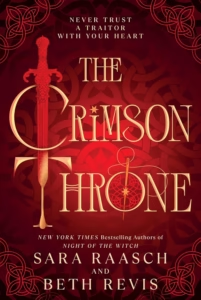The Crimson Throne
Sara Raasch and Beth Revis
Sourcebooks Fire
Published October 7, 2025
Amazon | Bookshop | Goodreads
About The Crimson Throne
Powerless meets Reign in this new historical romantasy from the New York Times bestselling authors of Night of the Witch.
Samson Calthorpe’s curse has isolated him from everyone he has ever cared about. So, when the opportunity arises to break the curse, he grabs it. All he has to do for his freedom is risk his life and become a royal spy, using every bit of the skills and resolve he’s picked up on the streets of London to infiltrate the court of the Scottish Queen and uncover a plot to assassinate Queen Elizabeth.
For years, Alyth Graham has been protecting Mary Queen of Scots from threats both physical and magical, including the Queen’s own husband, Lord Darnley. Alyth is more than meets the eye though, the child of a fae prince and a human mother, she is among the most powerful protectors in Scotland: guardians sworn to defend against the Red Caps, a bloodthirsty fae clan . . . that Lord Darnley is in league with to overtake Scotland.
As Alyth and Samson circle each other in the volatile and glamorous Scottish court, both seek to uncover threats to their own countries. They have one unifying link: their shared hatred and suspicion of Lord Darnley…and their undeniable pull towards each other. Using secret codes, hidden messages, and a little bit of magic, Alyth and Samson unravel a plot centuries in the making. Lord Darnley is only a pawn, and in this game, the queen takes all.
“A biting historical fantasy series launch that fuses Tudor-era courtcraft with Celtic fae legend… …confronting duty, destiny, and betrayal” —Publishers Weekly
“An atmospheric fantasy brimming with intrigue and heart.” —Kirkus Reviews
My Review
I really liked Night of the Witch, so I had this book on my reading list as soon as I saw it announced. This one is steeped in Scottish history with legendary creatures threaded throughout. I liked the way the authors blended history and myth together to tell a sort of alternate, magic-infused account of the reign of Mary, Queen of Scots.
As you’d expect with a romantasy, Alyth and Samson have an immediate, powerful connection, though it takes some time for them to stop denying it. I think it really works because though they should be enemies, they both have many reasons to question what’s happening and whether they really belong on opposing sides. I like that it takes a bit for them to overcome their resistance to their feelings of attraction. It created a lot of tension, which really kept me reading.
I’m very happy that I read this book. I think I like this even more than Night of the Witch, though I enjoyed that one, too. The sequel will absolutely be on my reading list next year.
Content Notes
Recommended for Ages 15 up.
Profanity/Crude Language Content
Strong profanity used somewhat frequently.
Romance/Sexual Content
Kissing. References to sex.
Spiritual Content
References to Queen Mary’s Catholic faith. Alyth is part fae, and has some ability to do magic. Other characters share similar lineage. The story contains other characters and creatures from Scottish folkstories.
Violent Content
Situations of peril. Characters use magical artifacts to control and/or kill others. Brief descriptions of characters attacking and killing someone.
Drug Content
One character is often drunk.
Note: This post contains affiliate links, which do not cost you anything to use but help support this blog. I received a free copy of this book in exchange for my honest review. All opinions are my own.
